Menus
- What you must remember
- Themore
- Theless
- Prices
- Make yourBMW F 750 GS 2020
- Opinion
- Replaces
- Performances
- The technical aspect
- Competitors
- Gallery
- Related articles
Qhen you are part of the GS family, you know that you will have to compose in the shadow of the big sister superstar, the unmistakable R 1200 GS. And when in addition to that, we carry around a twin sister F 800 GS who does everything the same, but better still, we have every interest in not resting on its laurels.
This is the story of the F 700 GS, which despite difficult positioning perseveres and becomes F 750 GS in 2018. (Next to it the F 800 GS also accelerates and is renamed F 850 GS). And although they both struggled to establish themselves on the market, the little Germans are right to hold on because the extension of the A2 license to all new bikers could well give them back at last: They are indeed eligible for category A2.
BMW’s entry-level trail therefore received a serious overhaul in 2018 with first a displacement increased by 55cm3 to now cub to 853cm3. Yes it is therefore an 850. Despite a less rewarding trade name, the little GS has the same mill as its sister, as was already the case with the F700 and F800. Visually almost identical, it is in the power and torque values that the two will stand out. And on their general aptitudes. One being more suited to off-road than the other.
So the other is her: The F 750 GS.
The first change for the F 750 GS comes in the design. More harmonious, (more ‘masculine, to take up the idea of BMW), the mid-size trail tackles a less divisive facies than when it arrived in 2012. The fairing sides gain in sharp angles and no longer have this one-piece look of the 700. They are moreover more enveloping towards the bottom. The line of the bike also changes on the side of the tank which takes a more classic place. Until then, this was placed at the rear of the bike with its characteristic gas hatch positioned on the rear shell. Abandoning this peculiarity in a desire for better mass centralization, the F750GS will carry its bump in a more conventional position. And although 1 liter of fuel has evaporated in the migration (15 liters), there is no need to worry since the range should always be around 300km for a Lilliputian consumption of 4.1L / 100km. This new ‘real’ tank contrasts with the fluidity of the previous line, which linked saddle and tank in the same gentle curve. This saddle, which went up high in the crotch on the F700GS, is lightly planed as the tank comes out almost vertically to the engine. If the visual rendering is certainly more striking, one wonders about the loss of comfort between the two generations. In return, the saddle is lowered by 5 mm for more accessibility. Be that as it may, this turnaround, in addition to improving the center of gravity, relieves the load on the rear, which in return carries a very useful standard luggage rack. And since it’s time for the big move, the engineers also made the decision to reverse the position of the exhaust and chain. The pot therefore turns to the right and the secondary transmission exiles to the left. A pot to the right of the grindstone, it avoids burning when it is maneuvered from the left side; side we use the most.
Reinvigorated by its new dress, the F 750 GS can finally show its new heart. Faithful to the parallel twin that has been driving it since 2012, the machine is gaining momentum. Set at 270 ° against 360 ° previously, the new twin cylinder is based on the previous 798cm whose bore and stroke have been increased to 84 x 77mm. If it’s slightly more powerful and more torquey on normal revs, it should especially be more lively. Thus it will now be necessary to count on 77 hp at 7500rpm and 8.4 mkg of torque at 6000rpm to move the F750GS, ie 2hp and 0.5mkg more than the F700. The 270 ° engine timing (found on the MT-07) should also transform the vocalizations of the machine for a more powerful and rewarding result. And since the engineers took the criticism into account, they also smoothed out unwanted engine vibrations with the two central balance shafts. Heavy riders will appreciate.
In addition to this new engine, the small FGS abandons its tubular trellis frame for a more rigid double steel beam. The swingarm is also redesigned for more rigidity.
On the suspension side, the new non-inverted telescopic fork is a reminder that the F750GS is still geared more towards urban trail. The travel of up to 170 mm is reduced to 151 mm! The F 750 GS clearly leaves its desires off road to the F 850 GS. Rear damping remains with the combined spring / central shock absorber.
The F 750 GS is full of electronics, as standard and (especially) as an option. Let’s start with the original equipment, which includes two Riding Modes (Rain and Road), anti-skating ASC, ABS, emergency call (a first on a mid-range model), the Dynamic brake light since 2019, and a revamped dashboard.
But BMW obliges, it will be necessary to go through various accessory packs to fully enjoy its machine. Thus, it will already be possible to swap this classic cockpit with a much more modern 6.5-inch high-tech color TFT screen, making it possible to manage the music, the telephone and the vital parameters of the machine..
But other appetizers can quickly tempt you. It will thus be possible to equip the F 750 GS with the electronically adjustable Dynamic ESA suspension, DTC traction control, a shifter, Pro riding modes which integrate ‘Dynamic and Enduro (the Enduro Pro being reserved for the F850GS), dynamic DTC brake light, full LED headlight with daytime running light, ABS Pro active in curves, Keyless Ride keyless start system, tire pressure control and the brand new 6.5 inch color TFT instrument panel.
With this development, the new BMW F750GS clearly increases its level compared to its predecessor and only the additional 12 kilos (224 kg fully loaded) tarnish the picture. Fans of off-road trips will naturally orient themselves towards the F 850 GS which offers more appropriate peripherals (inverted fork, long travel, narrow front tire on 21-inch spoke rim….) But for those who want to ride in GS without too much start neither its crampons nor its wallet, the F 750 GS 2018 retains serious advantages.
Available in two two-tone colors: White / Black (Light white) or Black / Gold (Austin Yellox metallic), the F 750 GS can also be dressed for a few hundred euros more in an ‘Exclusive’ dress with Black / Gray color. special matt, galvanized radiator cover, wide band GS, trim in granite gray, seat black / gray, handguard and handle anodized silver.
What you must remember
Themore
Theless
Prices
10,470 €
Price
nine
Compare
the credits
Make
yourBMW F 750 GS 2020
Estimate, calculate and compare the cost of insuring your motorcycle.
Calculate the cost of
insurance
Test the price of the motorcycle insurance specialist
Opinion
on 5 opinion
users
Read the reviews
Replaces
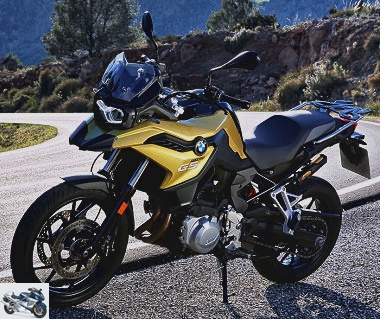
F 750 GS 2019
Model marketed in
2018
2019
2020
2021
Performances
-
Max speed:
about 190 km / h -
Acceleration
0 to 100: 4.10 s -
Consumption
medium: 4.10 l
The technical aspect
BMW F 750 GS 2020
- Frame
- Frame: Steel tube trellis
- Tank: 15 liters
- Seat height: 815 mm
- Length: 2,255 mm
- Width: 922 mm
- Wheelbase: 1,559 mm
- Operating weight: 224 kg
- Train before
- Telehydraulic fork Ø 41 mm, deb: 151 mm
- 2 Ø 305 mm discs, 2 piston calipers
- Front wheel:
110/80
– 19

- Transmission
- 6-speed gearbox
- secondary by chain
- Rear axle
- Mono-shock, deb: 177 mm
- 1 disc Ø 265 mm, 1 piston caliper
- Rear wheel:
150/70
– 17
- Motor
- Twin cylinder
in line
, 4 stroke - Cooling: by water
- Injection Ø 48 mm
- 2 ACT
- 4 valves per cylinder
-
853 cc
(84 x 77 mm) -
77
ch
at 7,500 rpm -
8.50 mkg
at 6,000 rpm - Compression: 12.7: 1
- Crit’air:
Detached pieces
exhaust
motor
fluid
electricity
filtration
braking
chain kit
Competitors
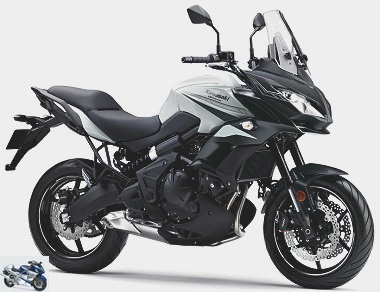
Kawasaki VERSYS 650 2020
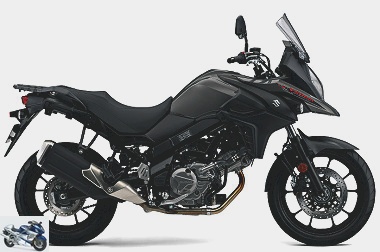
Suzuki DL 650 V-STROM 2020
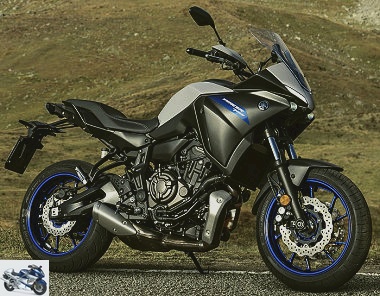
Yamaha 700 Tracer 2020
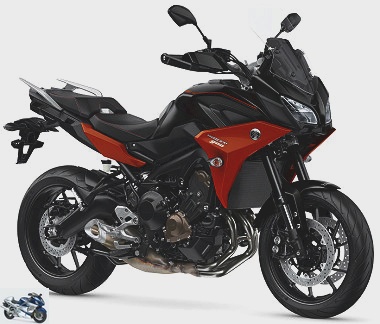
Yamaha 900 Tracer 2020
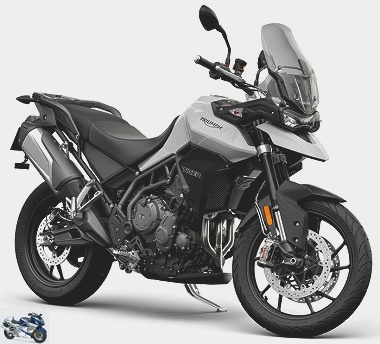
Triumph Tiger 900 2020
Gallery
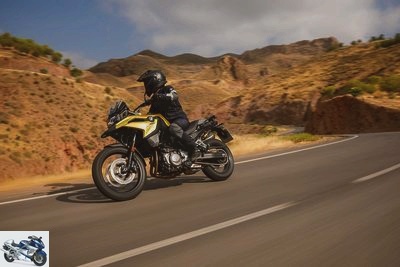
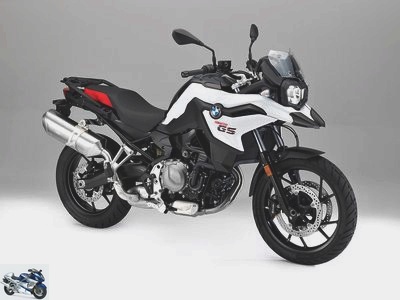
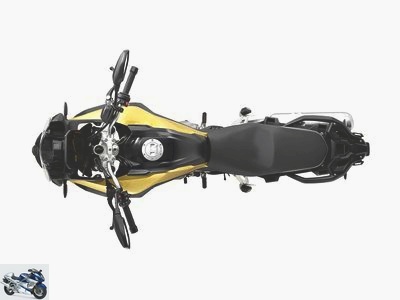
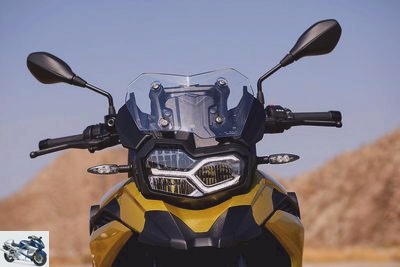
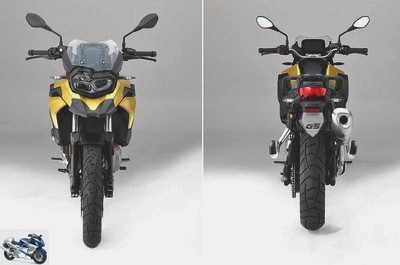
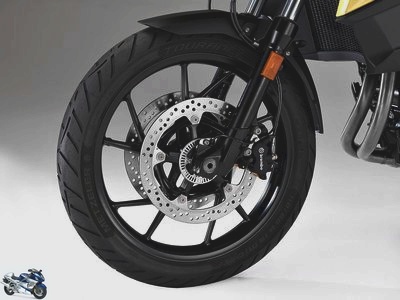
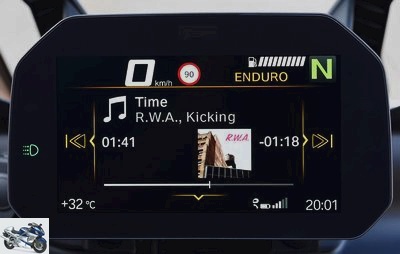
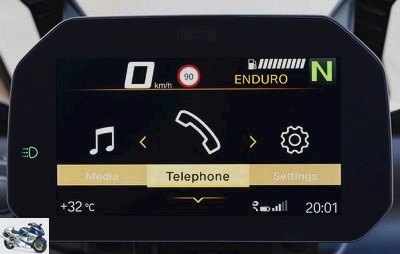
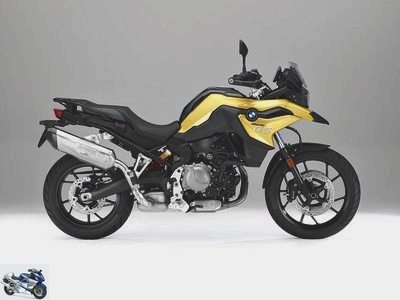
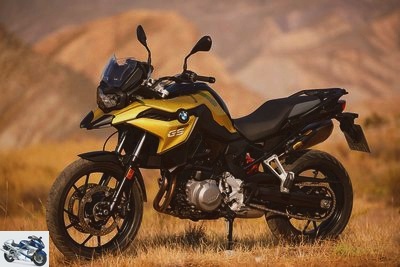
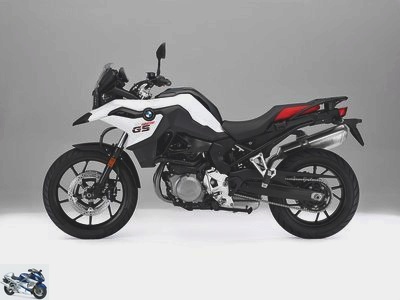
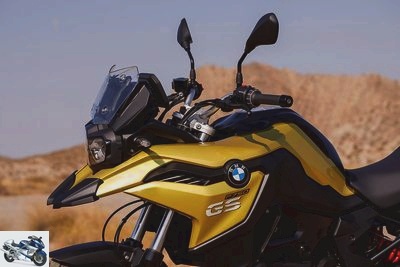
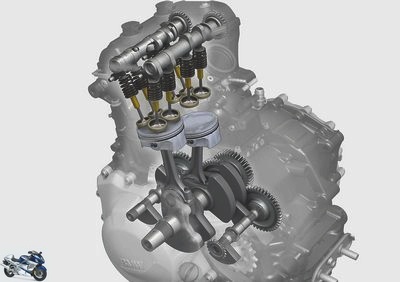

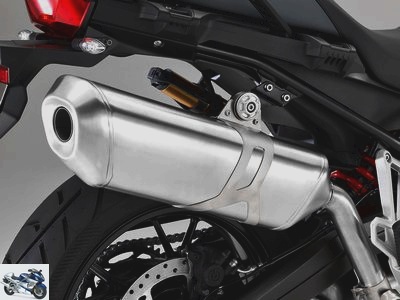

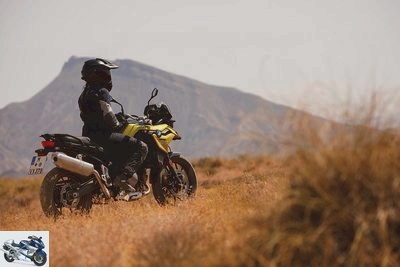
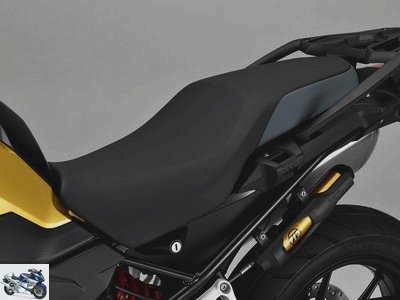
Related articles
-
T out keeping its ‘mid-range’ positioning, the F850GS pulls out its passport and kicks in on the Allan Quatermain asleep in us. Arrived in the fall of…
-
We’re not going to teach BMW to trail. Insolutely dominant in the category with the GS, it also has a strong punch in the field of maxi-trail-GT-Sport…
-
2020 Harley-Davidson 1870 Street Glide Special FLHXS
2020 is a moment of additional and dynamic technology for the Street Glide Special. The transplant of security solutions brings this bagger into a…
-
Moto-Guzzi 750 V7 III Stone 2020
When I talk to you about Italy, you think of the aromatic scents of Tuscany, of the wines you taste under the olive trees, of the antipasti savored in…
-
Shortly after its appearance, the Yamaha MT-10 had already received its first improvements. The most notable was the appearance of a QSS shifter,…
-
She is reborn the divine child! Expected like the messiah for several years, the illustrious Yamaha R6 has finally been resuscitated. Despite its age, it…
-
The CB 500s were given a facelift in 2019. Anxious to offer several facets to suit the first emotions of the medium displacement, this essential machine…
-
2020 Honda VFR 800 X CROSSRUNNER
Arriving early in the crossover category, the Crossrunner allowed the VFR to expand its field of action through a face and expanded skills. Thus, this…
-
Trail is almost a philosophy at BMW, it is essential for the Bavarian manufacturer to maintain the range at a high level. Of course, everyone immediately…
-
The trail segment has seen its tourism and power claims explode in recent years. It is almost endlessly available, ranging from GT to sports, from full…